Do frogs adapt their colouration to suit their habitat, or are there micro-evolutionary processes at work?
Below is a typical Slender Tree Frog, note the slender body with a tapering head. Also the pronounced dark stripe, extending through the eye to the lower flanks, as these are the more obvious features for quick identification.
The extent of green markings along the sides is extremely variable, as are the browns along the back.
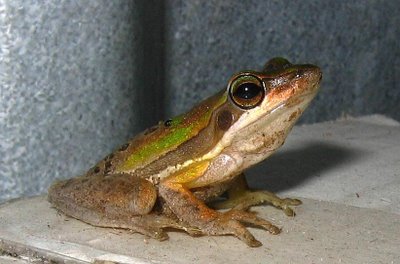
This other Slender Tree Frog has no green makings.
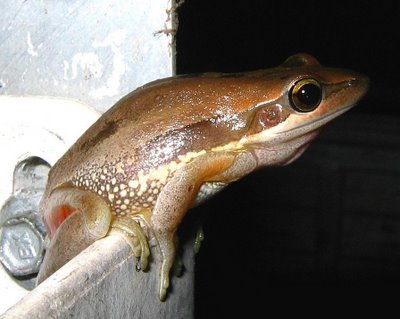
Less often seen is the bright red/orange on the backs of the thighs.
And even less seen, is the underside of these frogs, showing the large disks, the unwebbed fingers, but strongly webbed toes.
Now check out the frog colors as they relate to habitat.
See how the bright green patches and dark colouration blend into this tree/shrub habitat.

Also how the all brown marking of this frog match the tree, in this case the Flat Top Yate, Eucalyptus occidentalis that is common in ephemeral swampy areas.
Note the green reed-like colouration running the length of the frog with no markings along the back. This frog was very common with other similarly marked individuals on the Jointed Twig Rush, Baumea articulata, whose presence denotes areas of prolonged near surface freshwater.
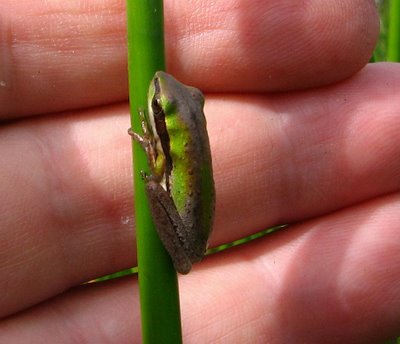
This frog is the greenest tree frog I have ever seen, it was living amongst low green sedges on the outer edge of an ephemeral swamp.
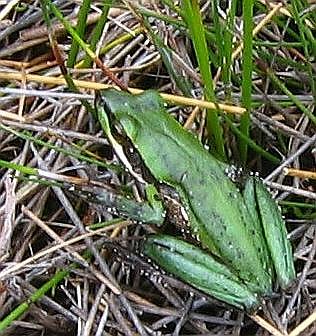
In the Esperance area, the above four very different colouration types would certainly assist the frogs survival within their preferred habitat. So is it something the frogs can influence, or is it a mini habitat variation, where variants are more easily spotted and eliminated by predators, thereby promoting compatible color forms within their micro-habitats?
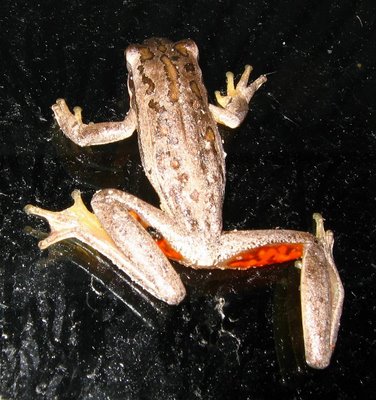
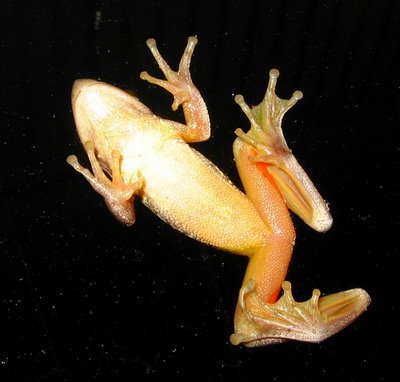

2 comments:
Intriguing questions and interesting obversations there!
I have previously wondered if frogs develop an individual colour variation due to a confined habitat, or if frogs can change individual colouration at will when it is convenient.
I cannot confidently identify frog species, but from my observations I am reasonably sure that one of the common local frogs here, Limnodynastes ornatus (Ornate Burrowing Frog) can vary in colour from sandy-cream to blotched dark grey-brown, depending on the substrate.
But I would be fascinated to know whether they take on the colouration as they develop in their habitat or change later to suit their changing habitat.
Gaye
Hi Gaye,
It should not be difficult to see if frogs can change color, although I doubt if they could do so to any degree, maybe the depth of color, but that may also be attributable to environmental factors like wet or dry, etc.
The all brown color and the green speckled frogs are by far the most common colouration for this species. The very green one and the elongated green reed type were only discovered in specifically large and lesser changing environments. This I would imagine, would lead to more local populations, where individuals were less likely to move far from their swamp, so favouring local colourations.
Freshwater swamps around me are very numerous, but most are very small (often less than a hectare) and usually dry quickly when the weather warms. Some years the water is not around long enough for these frogs to breed in these areas, so probably those further away from the larger swamps don't, but must wait until better rains fall.
What this means, is these Slender Tree Frogs are very widely spread in my area, but only the selectively larger and more permanent swamps regularly provide conditions for breeding to occur. This in turn would favour more local individuals, who in turn are more likely to blend into that particular environment. The remainder (brown and brown/green) occupy a much larger area with more diverse vegetation features and hence have no specific habitat modification. So the all brown frogs, and the green speckled frogs, are the ones most commonly encountered, but they too are color adaptive, but to more diverse environments.
Regards
Jack.
Post a Comment